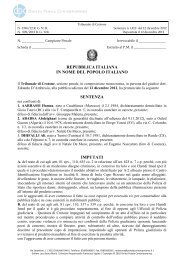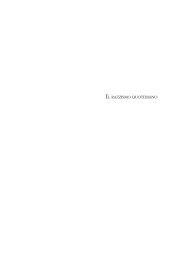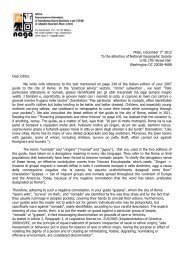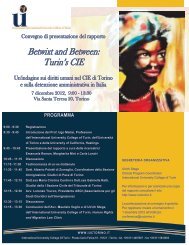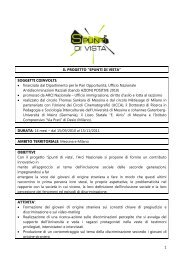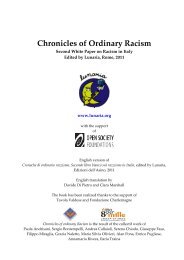Chronicles of ordinary racism 2011 - Cronache di ordinario razzismo
Chronicles of ordinary racism 2011 - Cronache di ordinario razzismo
Chronicles of ordinary racism 2011 - Cronache di ordinario razzismo
- No tags were found...
You also want an ePaper? Increase the reach of your titles
YUMPU automatically turns print PDFs into web optimized ePapers that Google loves.
Sanaa’s murder<br />
Paola Andrisani<br />
On 15th September 2009 Sanaa Dafani, an 18‐year old girl <strong>of</strong> Moroccan origin, is killed<br />
by her father, El Ke‐tawi Dafani, a 45‐year‐old Maroccan citizen, who stabs her<br />
repeatedly in the throat. The murder takes place in a wood next to Grizzo, a small<br />
hamlet belonging to the municipality <strong>of</strong> Montereale Valcellina in the province <strong>of</strong><br />
Pordenone. Her “Italian” partner Massimo De Blasio, 31, is driving Sanaa to the<br />
restaurant where she works as a waitress. Her father is lying in wait in a secluded road<br />
and attacks the young couple as soon as they get out <strong>of</strong> the car. Sanaa tries to escape but<br />
her father chases her down and kills her. Her partner, wounded during the<br />
confrontation, calls for help and informs rescuers that the murderer is Sanaa’s father. El<br />
Katawi Dafani is arrested and sentenced to life imprisonment as a result <strong>of</strong> the trial held<br />
in June 2010; the penalty is reduced to 30 years in January <strong>2011</strong>.<br />
Sanaa ‘s murder is a terrible and unacceptable crime. However, Sanaa’s body is violated<br />
again and again after her death in the course <strong>of</strong> a public debate that uses in<strong>di</strong>gnant<br />
rhetoric to launch yet another Islamophobic campaign and back he theory <strong>of</strong> the<br />
supposedly incompatible nature <strong>of</strong> <strong>di</strong>fferent “cultures”.<br />
From the very first, the me<strong>di</strong>a tends to interpret the murder as stemming from the<br />
alleged clash between <strong>di</strong>fferent religions and cultures. 238 And we are back to square one.<br />
Three years after the murder <strong>of</strong> Hina Saleem 239 in Brescia, the death <strong>of</strong> Sanaa is<br />
exploited in order to recycle the idea that the social and cultural integration <strong>of</strong><br />
238 Cf. among the others: Figlia musulmana ama un italiano, il padre la uccide (Muslim daughter loves an Italian. Her father<br />
kills her) 16 September 2009, Ansa; Pordenone: padre marocchino uccide la figlia, forse un altro caso Hina (Pordenone:<br />
Moroccan father kills his daughter. Another case like Hina’s 16 September 2009, Asca; Marocchina 18enne uccisa dal padre.<br />
Viveva col fidanzato. Vietato dalla tra<strong>di</strong>zione (Moroccan girl <strong>of</strong> 18 murdered by her father. She lived with her partner. Tra<strong>di</strong>tion<br />
forbids it.), 15 September 2009, “La Repubblica”; Il padre <strong>di</strong> Sanaa: ‘Era la mia vergogna’. La figlia uccisa perché conviveva<br />
con un italiano. Il pm: la pista dei motivi religiosi (Sanaa’s father: she was my shame’. Daughter murdered because she lived<br />
with an Italian. Prosecutor follows the line <strong>of</strong> enquiry <strong>of</strong> religious motives), 17 September 2009, “Corriere della Sera”; Uccide la<br />
figlia che ama un italiano. Gli amici: Era bella, voleva integrarsi (Murders daughter who loved an Italian. Her friends: she was<br />
beautiful and wanted to fit in), 16 September 2009, quoti<strong>di</strong>ano.net; Minigonne, lavoro e ragazzi. Sanaa uccisa perché occidentale<br />
(Mini-skirts, a job and men. Sanaa killed for belonging to the Western world) , 17 September 2009, “Il Giornale”; Giovane<br />
marocchina ama un italiano: il padre la uccide (Young Moroccan girl loves an Italian. Her father kills her), 16 September 2009,<br />
“Il Sole 24 Ore”; Marocchino accoltella a morte la figlia (Moroccan man stabs his daughter to death), 15 September 2009, “La<br />
Stampa”; Si fidanza con un italiano, marocchino uccide la figlia: le prime ammissioni (In a relationship with an Italian,<br />
Moroccan man kills his daughter: the first confessions), 16 September 2009, “Il Messaggero”; Il fidanzato è italiano. E il padre<br />
la uccide (The partner is Italian. Her father kills her), 16 September 2009, “Avvenire”; Amava un italiano “infedele”. Sanaa, 18<br />
anni, sgozzata dal padre a Pordenone. (She loves an Italian. ”infidel”. Sanaa, 18, butchered by her father in Pordenone), 16<br />
September 2009, “Il Gazzettino”; Musulmana ama italiano il padre la uccide (Muslim girl loves an Italian. Her father kills her),<br />
15 September 2009, “Il Secolo XIX”.<br />
239 The murder occurred during the summer <strong>of</strong> 2006. Hina Saleem, just turned 20, was born in Pakistan and immigrated to Italy in<br />
1999, aged 14, to be reunited with her family who lived in Sarezzo (BS). She quickly settled into Italian society, promptly<br />
learning the language, making friends, atten<strong>di</strong>ng schools and showing a certain degree <strong>of</strong> independence from her family. She had<br />
later found a job in a pizzeria in Brescia and decided to move in with her partner, Giuseppe Tempini, a 33-year-old blue-collar<br />
worker. It would appear that it was this decision to choose an “Italian non-Muslim” partner that particularly clashed with the will<br />
<strong>of</strong> the family who wished to marry her <strong>of</strong>f to a “Pakistani husband”, and from that moment the relationship between Hina and her<br />
family became tense. The murder unfolded in her father’s house where Hina is called on a pretext (the visit <strong>of</strong> a relative) while<br />
her father and some other male relatives lay in wait for her. Her mother (Bushra Begun, 46), brothers and sisters were on holidays<br />
in Pakistan. The final ruling <strong>of</strong> the court rejected the defense’s request to reduce the penalty for “cultural and religious reasons”.<br />
The ver<strong>di</strong>ct states that Hina was not killed by her father in name <strong>of</strong> “cultural or religious reasons or tra<strong>di</strong>tions” but because <strong>of</strong> a<br />
“twisted and pathologic relationship <strong>of</strong> parental possession” that made him unable to accept his daughter’s desire for freedom and<br />
autonomy.<br />
94




